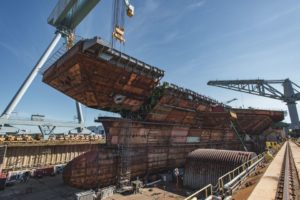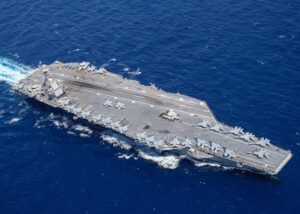Navy FY 2024 budget request documents revealed the next Ford-class aircraft carrier, the future USS John F. Kennedy
(CVN-79), is now expected to be delivered 13 months later than previously planned.
As recently as the FY ‘23 budget request documents, the Navy reported CVN-79 was expected to be delivered in June 2024, a period of 108 months from award to delivery and 160 months from the start of construction.

Now the FY ‘24 budget documents said delivery is being delayed by over a year to shift work from the Post Shakedown Availability (PSA) into the main construction period.
“The CVN 79 delivery date is being adjusted to July 2025 to support a revised ship delivery/post-delivery strategy. The Navy is implementing a strategy to pull baseline work from the Post Shakedown Availability (PSA) into the construction period in order to provide more capability at ship delivery.”
The budget argued this change in the schedule will prepare the Kennedy to better deploy and operate in the Indo-Pacific after it delivers.
“This approach will prepare CVN-79 as the first FORD class aircraft carrier to operate in the Indo-Pacific region and decrease the amount of time CVN-79 would be required to be at the shipyard after ship delivery to conduct the PSA,” the document said.
CVN-79s PSA will align to a traditional period of resolving discrepancies discovered during trials. The revised strategy maintains the overall ‘ready for deployment workups’ milestone for CVN 79,” the budget documents continued.
CVN-79 was originally set to be delivered in two phases, but the Navy switched that to a single-phase delivery in 2020.
The original plan would have CVN-79’s hull, mechanical and electrical construction be delivered by the middle of FY ‘22 followed a nine-month post-delivery shakedown, then an 18-month post-shakedown availability/selective restricted availability for Phase II work to incorporate items like the Enterprise Air Surveillance Radar (EASR) and procure and install electronics as late as possible to preempt obsolescence management later.
The two-phase goal aimed to get the carrier delivered faster to replace the USS Nimitz (CVN-68) by the time it retires this decade.

However, in March 2020, the Navy said it decided to change to a single-phase process to mitigate schedule risk and reduce post-delivery costs, without any expectation it would delay the final delivery schedule for 2024 (Defense Daily, March 27, 2020).
Later that year, the Navy awarded shipbuilder HII [HII] a $315 million modification to change from a two-phase to a single-phase delivery process as well as include F-35C capabilities (Defense Daily, Nov. 3, 2020).
Accordingly, the FY ‘24 budget documents now said the change to making CVN-79 single phase added 24 months to the CVN-79 detail design and construction contract to incorporate the EASR, F-35C Joint Strike Fighter modification, “and the resolution of technical items discovered late in the CVN 78 program.”
“To support the added duration and incorporation of new systems, additional funding is required for engineering and logistics products as well as light off and certification of the new combat system,” the documents added.
The year-long delay will now make the time from contract award to delivery increase from 108 months to 121 months and construction start to delivery increase from 160 months to 173 months.